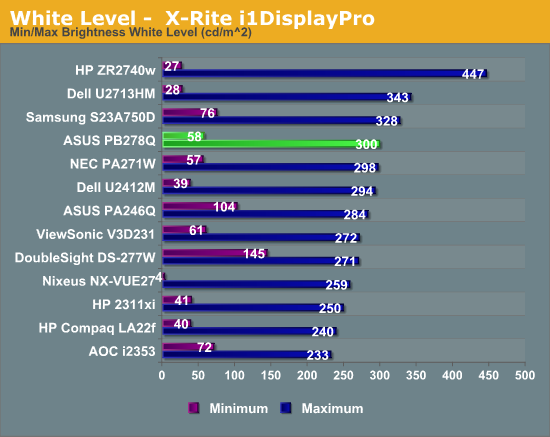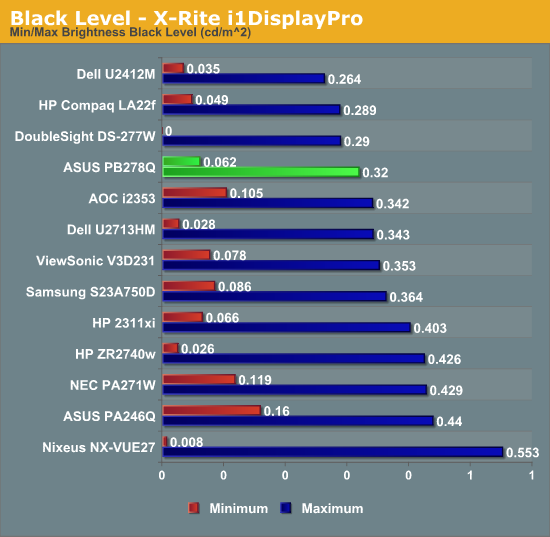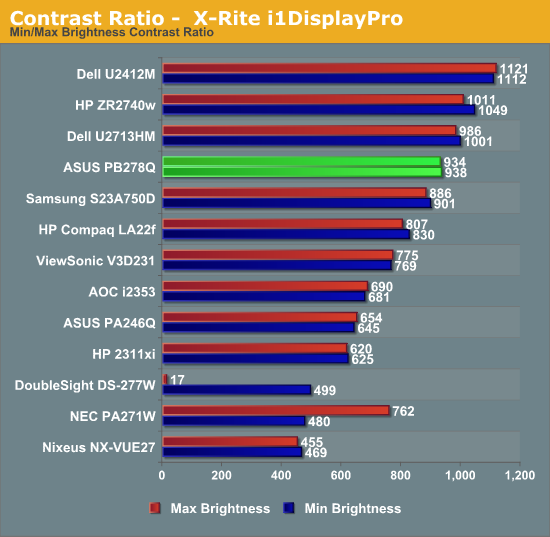ASUS PB278Q Review: An IPS Competitor Emerges
by Chris Heinonen on November 19, 2012 11:00 PM ESTASUS PB278Q Brightness and Contrast
ASUS says that the PB278Q can do 300 nits at maximum brightness, and that spec hits it right on the head. With a full white screen and the brightness pushed up all the way, I got exactly 300 nits of light output from the display. One of PLS' advantages over IPS is supposed to be the ability to let more light through, though this number is very close to what other 27” displays achieve. It might be able to do this using a lower powered LED backlight, and we will test that out in power usage later to see if that is the case.
With the brightness at minimum, we get 58 nits of brightness which should be low enough for virtually every user. The lowest that most users might set a display to is probably 80 nits, and so as long as a display goes below that level I think that is a perfectly acceptable minimum brightness level. This range from 58 to 300 should also accommodate virtually all users for their brightness requirements.

Before measuring the black level, I made sure to disable dynamic contrast, as it would likely just disable the LED backlight and give a result of 0 for a black screen. Since no one really uses an all black screen in this way, I don’t feel that testing it is appropriate. With the backlight at maximum the black level was 0.32 nits, and at minimum it was down to 0.062 nits. This is a decent minimum black level for a display, and good for IPS, but not as exceptional as some displays can manage.

The black level looks better when used to calculate the contrast ratio of the display here. With a contrast ratio right around 935, this is right around what we see for other 27” IPS displays. The PLS display seems to be equal to what other IPS displays can manage, not really much better or worse, but right down the middle of the range.

Brightness and Contrast details are right in line with what we expect from an IPS display, and since PLS is very similar to IPS we see very similar results. The peak brightness is lower than some IPS displays, but most people don’t use more than 300 nits and we will see later if this enabled ASUS to use a lower power backlight.










55 Comments
View All Comments
Old_Fogie_Late_Bloomer - Wednesday, November 21, 2012 - link
I don't really mind the 16:9 aspect ratio so much anymore; it's the 1080 lines of resolution that get me. I have a 1600x1200 monitor and a 1920x1080 monitor at work...the former is my primary monitor, 'cause those 120 pixels matter when coding or looking at spreadsheets. I'd swap the 1080p monitor for another UXGA one if I could (but I was lucky to office-scavenge the one I have :-P ).If manufacturers wanna go 4K at a reasonable price, that's fine. Otherwise, I guess my next monitor purchase will probably be a U2711 (or another U2410).
devilmon - Tuesday, November 20, 2012 - link
I think you forget to test about Responsiveness of pixel on this monitor. I think overdrive / response time compensation (RTC) technology is the best feature that cannot found in other high-end monitor.PS. I'm quite surprise why your test result is far from another review. Do you use defect monitor?
http://www.tftcentral.co.uk/reviews/asus_pb278q.ht...
Ryan Smith - Tuesday, November 20, 2012 - link
We don't have pixel response time tests with different TraceFree settings, but we do have tests at the stock setting of 60.http://images.anandtech.com/doci/6460/Input%20Lag....
11ms pixel response time + 17ms input lag
cheinonen - Tuesday, November 20, 2012 - link
TraceFree doesn't affect the lag time at all in my testing. I ran SMTT at all the various TraceFree settings and that doesn't change the lag at all. It does change the ghosting of the LCD which I did comment on, but it didn't change the lag in my testing.Krysto - Tuesday, November 20, 2012 - link
Nexus 10 has a PLS screen, too. And it's actually slightly higher resolution than this.dingetje - Tuesday, November 20, 2012 - link
thx for the reviewif have a question:
will the EVGA Z77 Stinger Mini-ITX Motherboard be in the upcoming mini itx round-up article?
fragemall - Tuesday, November 20, 2012 - link
I think its time to move on from using excel to generate those surface plots. Virtually any software (including Matlab) can be used to make a better figure.cheinonen - Tuesday, November 20, 2012 - link
I'm aware of this and have been working on making the charts better, I just haven't decided on something yet but will try to figure it out soon.Crazyeyeskillah - Tuesday, November 20, 2012 - link
It's too bad the lag is so high, that is incredibly noticeable and you will feel it in every fps game you play, there is no covering it up, this is not a gaming monitor but a graphics/editing monitor, don't waste your money if you are a gamer. Scaler=FailerSubyman - Tuesday, November 20, 2012 - link
I recently purchased a Viewsonic VP2770 that uses a PLS panel. I'm enjoying it more than the IPS panels I've had in the past. It has all the features that I was looking for such as non-PWM backlight, USB 3.0 hub, 27", 1440p, good selection of inputs, and a good stand. Too bad more places do not review it.